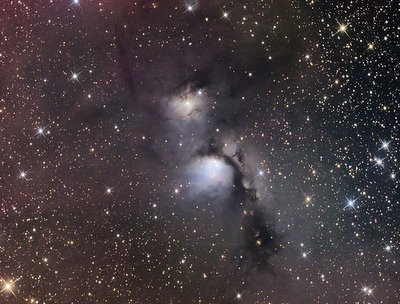 Credit & Copyright: Stephan Messner
Credit & Copyright: Stephan Messner Explanation: Interstellar dust clouds and bright nebulae abound in the fertile constellation of Orion. One of the brightest, M78, is just below center in this sharp widefield view, covering an area north of Orion's belt. At a distance of about 1,500 light-years, the bluish nebula itself is about 5 light-years across. Its blue tint is due to dust preferentially reflecting the blue light of hot, young stars in the region. Dark dust lanes and other nebulae can easily be traced through this gorgeous skyscape that also includes the remarkable McNeil's Nebula -- a newly recognized nebula associated with the formation of a sun-like star.
NASA: ASTRONOMY PHOTO OF THE DAY
NASA: ASTRONOMY PHOTO OF THE DAY







2 comments:
I love the pictures that you post like this, that one with purple light that streamed in a tunnel like manner was incredible. The majesty and sheer beauty of nature is undeniable. I am let down when people would automatically claim supernaturalism created such natural occurrences (it demeans the experience to me). Interstellar space is fascinating and sometimes completely incomprehensible (for me) but that does not mean that I will insert occult postulates where they do not belong.
Cool picture!
JD- I think these images are absolutely mind-boggling. To simply attribute the vastness and complexities of the universe to some "creator" is far too simplistic. There are so many things we don't know, and so much we will never know -- but also there are many things we have learned and are able to observe thanks to dedicated scientists. We can appreciate the beauty and magnificence of nature without attributing it to any supernatural or magical causes.
Post a Comment